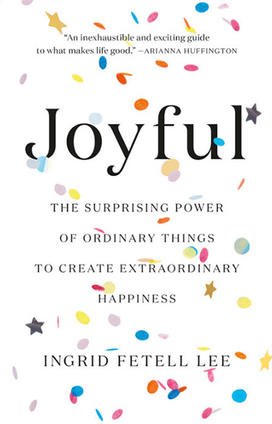Ingrid Fetell Lee ’02 Helps Those Seeking Joy

Throughout 10 thematic chapters, Lee presents personal experiences, anecdotes, and psychology. Examples include “Energy,” where Lee describes how bright, energetic colors improved prospects of an Albanian town and New York City schools, and “Surprise,” where Lee talks about the surprising joy of seeing a rainbow-socked executive in a business meeting and finding hidden love notes from her husband.
The author: Ingrid Fetell Lee ’02 is a designer and founder of the blog The Aesthetics of Joy. She was formerly design director at global innovation firm IDEO and was a founding faculty member in the products of design program at the School of Visual Arts in New York City.

Suddenly, they were all smiling. I felt a wave of relief. I had passed my first review in the industrial design program at Pratt Institute. But my relief soon gave way to confusion. Joy was a feeling, ephemeral and elusive. It wasn’t something we could see or touch. How, then, could such simple objects — a cup, a lamp, a stool — elicit joy? I tried to get the professors to explain, but they hemmed and hawed as they gestured with their hands. “They just do,” they said. I thanked them, but as I packed up my things for the summer, I couldn’t stop thinking about this question.
How do tangible things create an intangible feeling of joy?
At first, the answer seemed unequivocal: They don’t. Sure, there’s a certain pleasure in material things, but I’d always been led to believe that this is superficial and short-lived, not a meaningful source of joy. In all the books on happiness that I’d consulted over the years, no one had ever suggested that joy might be hiding inside my closet or kitchen cabinets. Instead, countless experts agree that the kind of joy that matters is not around us but in us. This perspective has roots in ancient philosophical traditions. The teachings of Buddha, for example, advise that happiness comes only from letting go of our attachments to worldly things, while in ancient Greece the Stoic philosophers offered a similar prescription, rooted in self-denial and rigorous control over one’s thoughts. Modern psychology likewise embraces this inward lens, suggesting that the way to a happy life is to change how we look at the world and our place in it. From mantras and meditation to therapy and habit change, true joy is an exercise of mind over matter, not matter over mind.
Yet in the weeks and months that followed my review, I noticed many moments when people seemed to find real joy in the material world. Gazing at a favorite painting in an art museum or making a sandcastle at the beach, people smiled and laughed, lost in the moment. They smiled, too, at the peachy light of the sunset and at the shaggy dog with the yellow galoshes. And not only did people seem to find joy in the world around them, but many also put a lot of effort into making their immediate environment more delightful. They tended rose gardens, put candles on birthday cakes, and hung lights for the holidays. Why would people do these things if they had no real effect on their happiness?
A body of research is emerging that demonstrates a clear link between our surroundings and our mental health. For example, studies show that people with sunny workspaces sleep better and laugh more than their peers in dimly lit offices, and that flowers improve not only people’s moods but their memory as well. As I delved deeper into these findings, joy started to become less amorphous and abstract to me and more tangible and real. It no longer seemed difficult to attain, the result of years of introspection or disciplined practice. Instead, I began to see the world as a reservoir of positivity that I could turn to at any time. I found that certain places have a kind of buoyancy — a bright corner café, a local yarn shop, a block of brownstones whose window boxes overflow with blooms — and I started changing my routines to visit them more often. On bad days, rather than feeling overwhelmed and helpless, I discovered small things that could reliably lift my spirits. I started incorporating what I learned into my home and began to feel a sense of excitement as I put my key into the lock each evening. Over time, it became clear to me that the conventional wisdom about joy was wrong.
Joy isn’t hard to find at all. In fact, it’s all around us.
Reviews: “Joyful is an invaluable field guide to discovering delight in all its forms. It’s hard to look at the world — and your place in it — quite the same way again.”
―Bianca Bosker ’08, New York Times bestselling author of Cork Dork











No responses yet